New COO Digital & Decarbonisation
World Leading Maritime Decarbonisation Advisory Services company VPS, is pleased to announce the appointment of Jan Wilhelmsson, as the company’s new COO Digital & Decarbonisation. In this role, Jan will lead the strategic initiatives aimed at advancing VPS's digital and decarbonisation efforts. His leadership will play an essential role in steering the company towards sustainability and innovation in decarbonisation advisory services.

Jan brings with him extensive cross functional experience in driving maritime digital transformation for operational efficiency and carbon reduction. At the start of his career 30 years ago, he sailed and reached Master unlimited certification, followed by a fast-ascending commercial shipping career, operating large fleets. Since 2013 Jan has fully focused on digital transformation and decarbonisation across the shipping industry. Also, within transformation he has held top corporate positions as Chief Digital Officer for a world leading independent operator of tankers, as well as various top management positions and board assignments across the maritime tech industry.
Dr. Malcolm Cooper, VPS CEO, stated: “With growing complexity and our clear strategy to become the world leading decarbonisation advisory service in our sectors, we are very pleased to have Jan onboard to drive a consolidated decarbonisation strategy for our Emissions Measuring, Software Development and Fuel Testing Data capabilities.”
“The recent and upcoming emissions regulations will require a better understanding how different fuels affect what goes out the chimney.” Said Jan Wilhelmsson. “In order to truly reduce emissions going forward, we need to better understand the composition of the fuels used, how they were sourced, how they are burned, and the complexity of the total emissions. I am very excited to work with teams that are true experts across the carbon chain, combining fuel testing with emissions measurement and operational efficiency. Together, we will develop the digital tools necessary for true decarbonisation that the industry needs”.
The importance of testing for accurate energy content of biofuels | Abstract
VPS/WHP-01-23
Biofuels have the benefit of reducing greenhouse gas emissions compared to conventional carbon-based marine fuels. VPS has carried out significant research across numerous test parameters that enables the potentially problematic characteristics of marine biofuels to be measured and controlled. VPS research has shown that by using these test methods, biofuels can be used as drop-in fuels on board vessels enabling the benefits of such fuels to be realised in the shipping sector.
VPS has published a white paper covering one specific test parameter: the energy content of biofuels. Energy Content is a key parameter, representing the amount of heat transferred within the combustion chamber during the burn process and indicates the available energy from the fuel. Higher energy content results in higher power generation and better combustion efficiency. The energy content has a direct impact on fuel economy and greenhouse gas emissions, and is therefore an important parameter for Ship Operators to consider in preparation for the EU ETS. The paper covers a range of fuel types, from 100% FAME through to FAME blends with MGO, HFO and VLSFO.
For conventional residual and distillate fuels, the energy content can be calculated within an acceptable degree of accuracy using a formula specified in Appendix H of the International Marine Fuel Standard ISO 8217:2017. The VPS research paper compares data from a variety of fuel samples to correlate the calculated energy content versus the measured energy content (using ASTM D240) of conventional fuels and FAME blends through to 100% FAME. The data shows that this correlation falls away at FAME content above 10%. This proves that the ISO 8217 calculation method cannot be relied upon to provide accurate energy content for fuel blends containing more than 10% FAME and that for these blends the accuracy of the calculation formula is not acceptable. This inaccuracy is due to the greater oxygen content of FAME as compared to conventional fuels. Furthermore, there is no calculation method available to calculate the energy content of biofuels accurately due to the variability of the oxygen content in the FAME.
Measuring the energy content in fuels is crucial for assessing fuel efficiency, managing operational costs, evaluating environmental impact, ensuring compliance, and maintaining engine performance and safety. It provides valuable information for ship operators to make informed decisions regarding fuel selection, consumption, and environmental responsibility.
The full VPS paper includes:
- Methods to Determine Energy Content in Marine Fuels.
- Methodology Applied to Compare Different Methods of Determining Energy Content.
- Comparison of Energy Content of HFO, VLSFO, MGO Samples and Biofuel samples.
- Significant conclusions relating to the energy content of marine biofuels.
If you would like to receive the full VPS White Paper, “The Importance of Testing for Accurate Energy Content of Biofuels” please click here: Request White Paper
Marine Bunker Fuels Review | 2023
By Steve Bee, VPS Group Commercial Director
Introduction
2023 saw the continuing evolution and the widening of available maritime fuel types and grades, as the global shipping industry gathered decarbonisation momentum to reduce its emissions and achieve current and future legislation targets. Existing CII and EEXI requirements, the incoming EU ETS legislation, plus the slightly longer-term IMO legislation, saw increasing demand for additional testing, lower-carbon fuels, data and digitalisation solutions across the shipping sectors.
As the leading maritime decarbonisation testing and advisory services provider, VPS continued to be at the forefront of marine fuels and lubricants analysis, utilising our experience, expertise and innovative approach, to support this drive for a more sustainable shipping fleet.
Throughout the year, VPS witnessed further fuel quality issues with VLSFOs in terms of cold-flow property issues, sulphur compliance and cat-fines. HSFO and VLSFO suffered numerous degrees of chemical contamination, whilst MGO suffered from cold-flow, flash point and FAME off-specifications.
Biofuels usage certainly gathered momentum and the increased demand from the market led to increasing queries regarding their fuel management and their “fit-for-purpose” as a drop-in marine fuel, which in turn called upon VPS to provide answers and solutions to customers, utilising our extensive knowledge and understanding of biofuels and their associated test parameters.
The Marine Fuel Mix
Across 2023, the fuel mix with respect to samples received for testing in VPS laboratories, equated to 62.7 million MT, which is over 5 million MT of marine fuels per month. VLSFO was the most popular marine fuel with 54.3% of the fuels used, followed by 29.5% HSFO (a growth of 15.4% over 2022), 14.2% MGO, 1.2% ULSFO and 0.8% Biofuels. Regarding biofuels usage, the samples tested by VPS equated to an increase from 231,000 MT in 2022 to 558,000 MT in 2023.
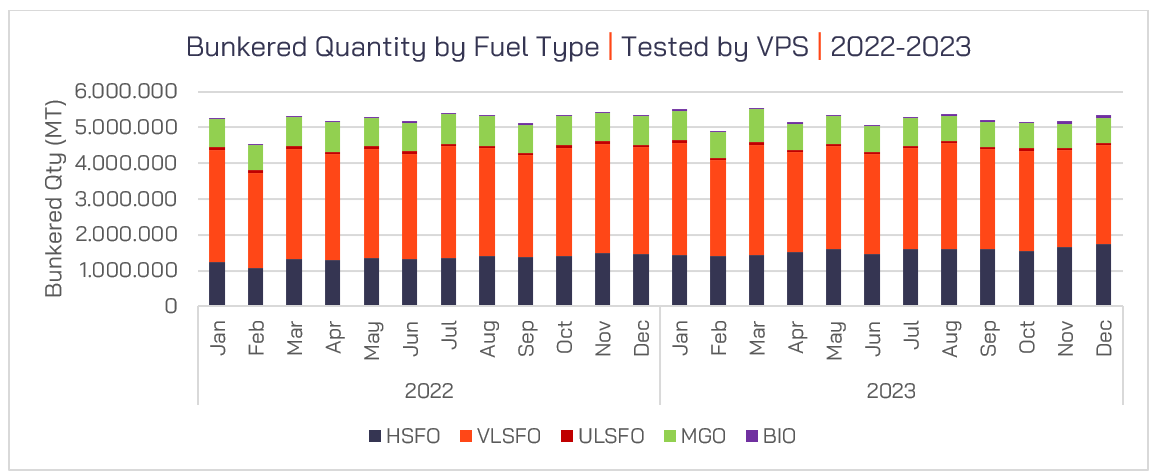
VPS Bunker Alerts
Bunker Alerts highlight short term quality fuel quality issues identified by VPS, for a specific test parameter of a specific fuel grade/type in a specific port. The service provides valuable information to customers, to assist in avoiding potentially problematic fuel types in a highlighted port or region, to further protect the customer’s asset and crew.
In 2023 VPS issued 28 Bunker Alerts, eight fewer than in 2022. The 2023 Bunker Alerts included all major fuel grades, i.e. VLSFO, HSFO, MGO and ULSFO, ten different test parameters, 12 ports and 9 countries.
58% of the 2023 Bunker Alerts were for VLSFO fuels, followed by 24% for MGO fuels and 14% for HSFO. The most common problematic parameter was Flash Point, accounting for 28% of the Bunker Alerts, followed by Sodium at 24%, with Sulphur and TSP at 10% each.
Singapore (32%) and ARA (21%) were the regions/ports most frequently requiring a Bunker Alert to be issued. But as these are the two busiest bunkering regions, it is not too surprising.
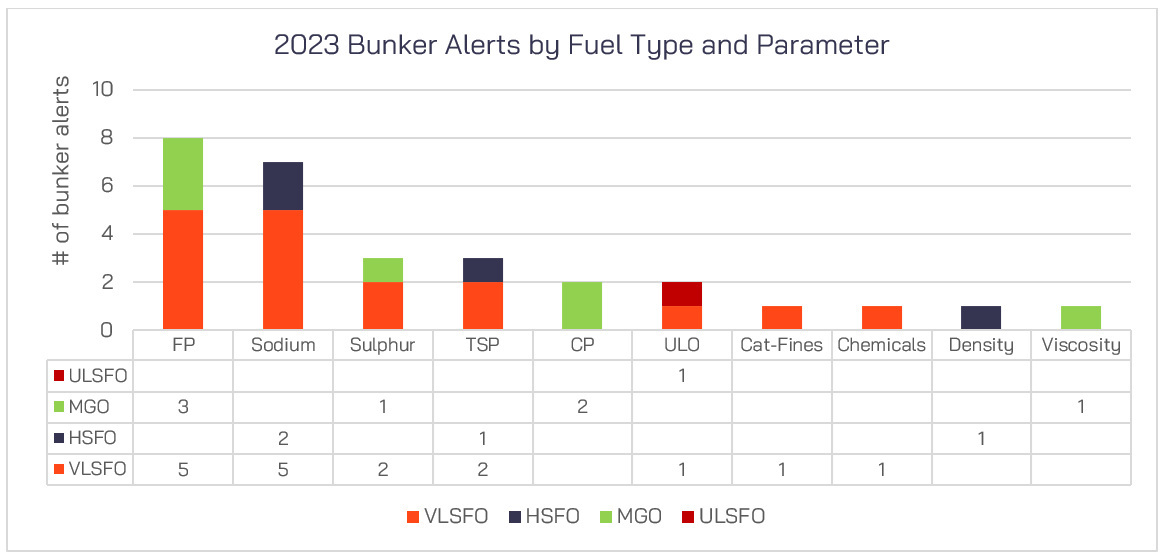
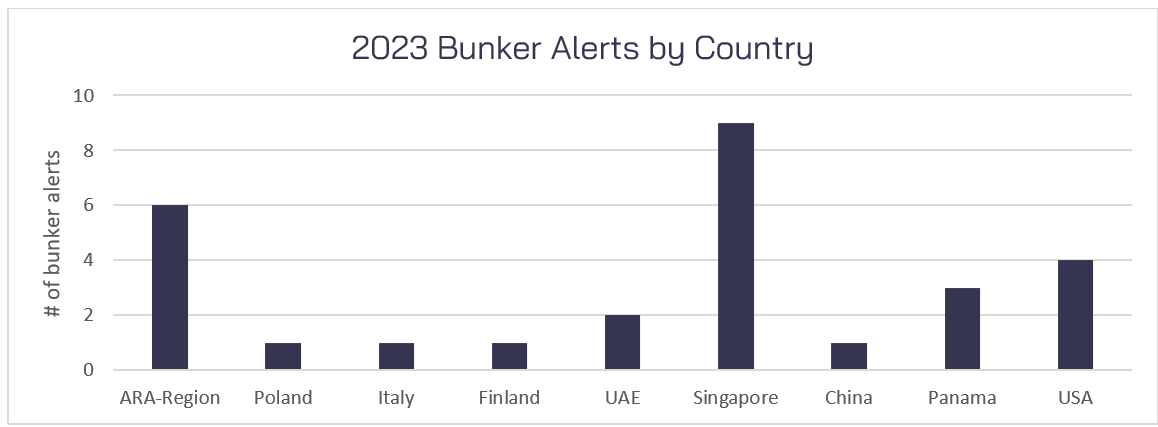
VLSFO Fuel Quality
As the most used marine fuel type, VLSFO accounts for more than half of the fuels tested by VPS. In terms of quality, Europe provided the highest level of off-specification VLSFOs in both 2023 (7.8%) and 2022 (7.9%). Africa provided the next highest level of off-specification fuels with 6.7% in 2023 and 7.0% in 2022, with North America third with 4.4% of fuels tested exhibiting at least one off-specification parameter in 2023 and 4.3% in 2022.
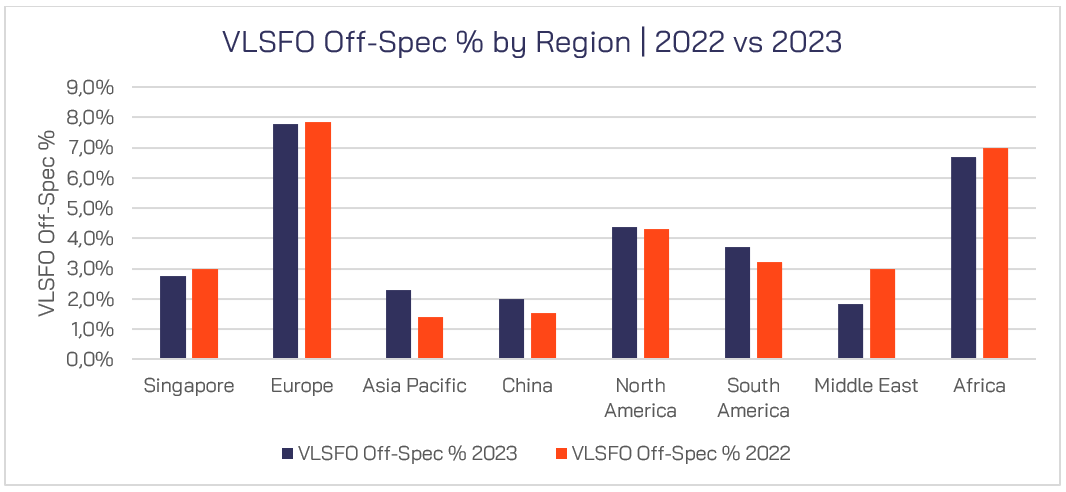
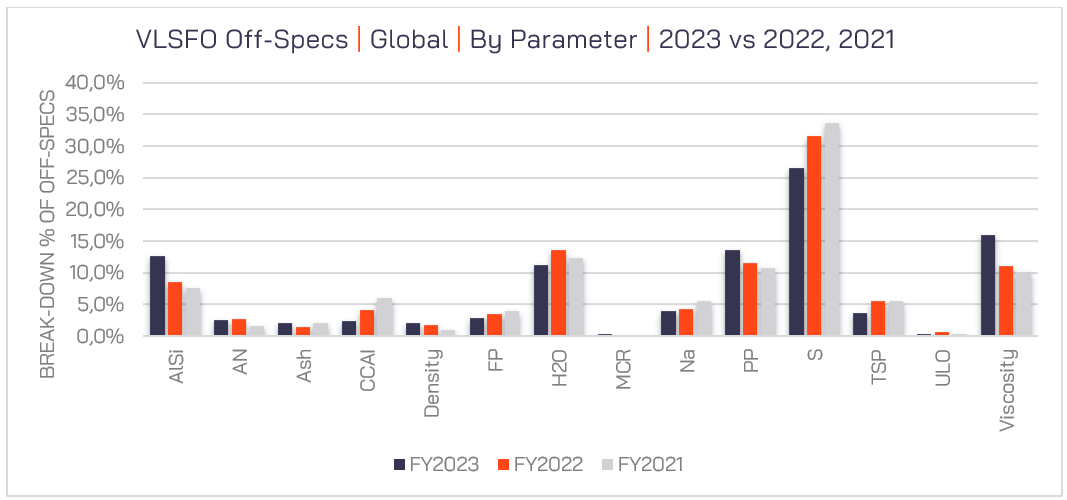
Sulphur is the most common off-specification parameter of VLSFOs, accounting for 26.6% of VLSFO off-specs in 2023 and 31.5% in 2022. 0.7% of VLSFOs tested in 2023 had a sulphur level of 0.50%-0.53%, with 0.5% of samples tested having a sulphur level greater than 0.53%.
Pour Point was also a common off-specification parameter for VLSFOs with 13.6% of VLSFOs off-specs relating to this parameter in 2023 an increase over the 11.4% level witnessed in 2022.
The importance of the additional cold-flow test of Wax Appearance Temperature (WAT) and Wax Disappearance Temperature (WDT), was highlighted in 2023 with 63% of VLSFOs exhibiting WAT of 31-40ºC and 14% having WAT between 41-50ºC. 55.7% of VLSFO samples had a WDT of 41-50ºC, with 28.1% having a WDT of >50ºC. VLSFOs cold-flow properties are a definite concern with wax precipitating from the fuel at temperatures way in excess of 10ºC above the pour point, potentially causing numerous operational problems such as filter and pipework blockages.
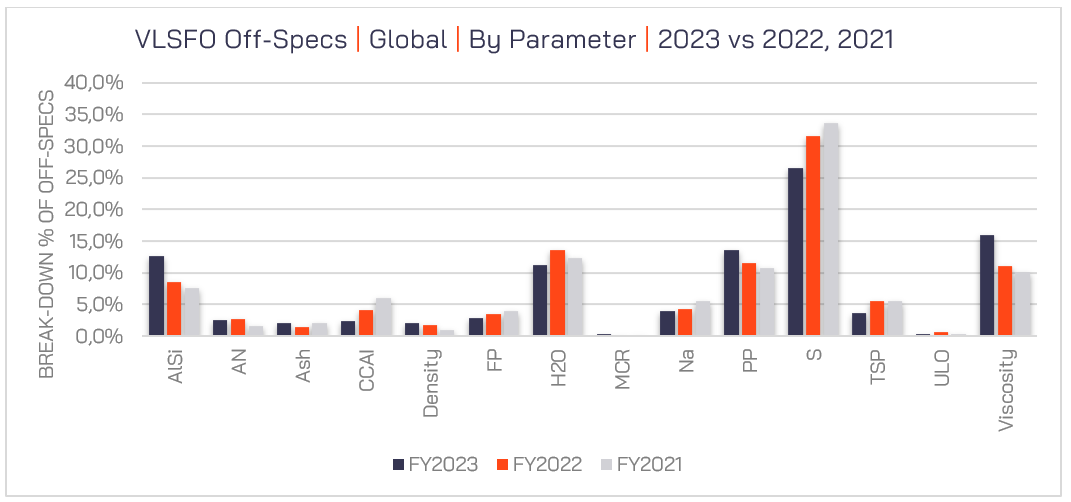
Sulphur is the most common off-specification parameter of VLSFOs, accounting for 26.6% of VLSFO off-specs in 2023 and 31.5% in 2022. 0.7% of VLSFOs tested in 2023 had a sulphur level of 0.50%-0.53%, with 0.5% of samples tested having a sulphur level greater than 0.53%.
Pour Point was also a common off-specification parameter for VLSFOs with 13.6% of VLSFOs off-specs relating to this parameter in 2023 an increase over the 11.4% level witnessed in 2022.
The importance of the additional cold-flow test of Wax Appearance Temperature (WAT) and Wax Disappearance Temperature (WDT), was highlighted in 2023 with 63% of VLSFOs exhibiting WAT of 31-40ºC and 14% having WAT between 41-50ºC. 55.7% of VLSFO samples had a WDT of 41-50ºC, with 28.1% having a WDT of >50ºC. VLSFOs cold-flow properties are a definite concern with wax precipitating from the fuel at temperatures way in excess of 10ºC above the pour point, potentially causing numerous operational problems such as filter and pipework blockages.
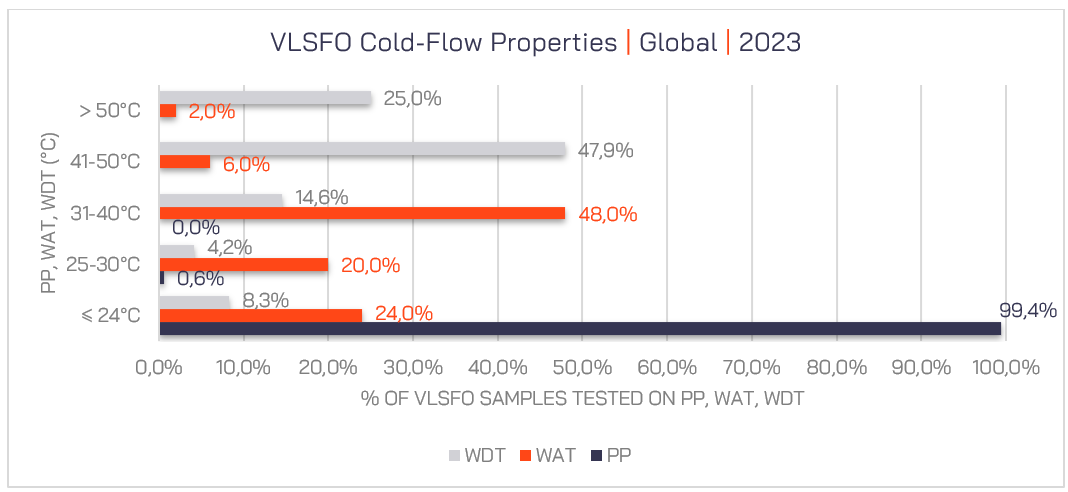
2023 also saw a significant increase in cat-fine levels in VLSFOs, with 12.7% of all off-specifications relating to this parameter, compared to 8.5% in 2022. 16.2% of all VLSFOs showed a cat-fine level greater than 40ppm. Frequent checking of purifier efficiency via VPS’ Fuel System Checks (FSC) service is a highly recommended proactive safeguard in respect to increased cat-fines within VLSFOs.

VLSFO viscosities vary enormously depending upon to blend components used. In 2023 VLSFO viscosities ranged from <20Cst to >380Cst. 16% of all VLSFO off-specifications were due to viscosity. Only 0.5% of VLSFOs had a viscosity of >380Cst. 68% of all VLSFO viscosities were less than 180Cst. Viscosity is such a key operational parameter, determining the transfer and injection temperatures of fuel onboard ships and therefore determining the exact viscosity of VLSFOs is crucial to ensure optimal efficiency.
HSFO Fuel Quality
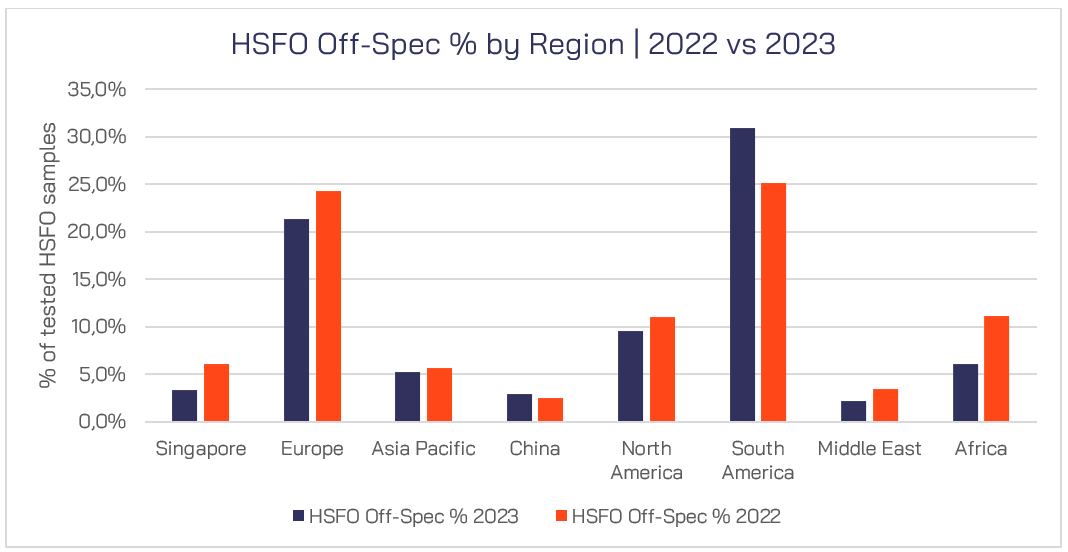
HSFO represents almost 30% of all bunker samples received by VPS for testing, indicating a relatively high level of scrubber usage onboard vessels today. In terms of HSFO off-specifications, South America accounted for 30.9% of off-specs, compared to 25.1% in 2022. Second highest off-spec region was Europe, with 21.4% in 2023 compared to 24.3% in 2022 and North America was third with 9.5% of HSFO off-specs in 2023, compared to 11% in 2022.
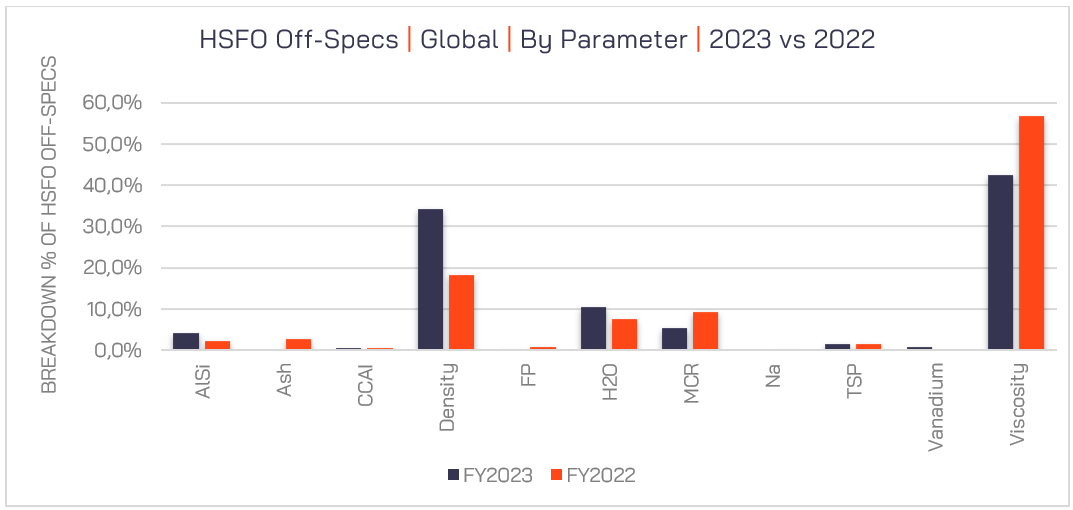
As usual, viscosity and density were the two most common HSFO off-spec parameters in 2023, with 42.5% of the off-spec attributed to viscosity and 34.3% to density, compared to 56.7% and 18.2% respectively in 2022. Water was the third most frequent HSFO off-specification parameter in 2023, with 10.5% off-spec level compared to 7.6% in 2022.
Whilst cat-fines accounted for 4.2% of HSFO off-specs in 2023, this was almost double the 2022 level of 2.2%. Again, like VLSFOs it highlights the importance of Fuel System Checks (FSC) to protect the engine from potential damage from this corrosive contaminant, by improving purifier efficiency. 20.3% of HSFOs had a cat-fine level of >40ppm in 2023.
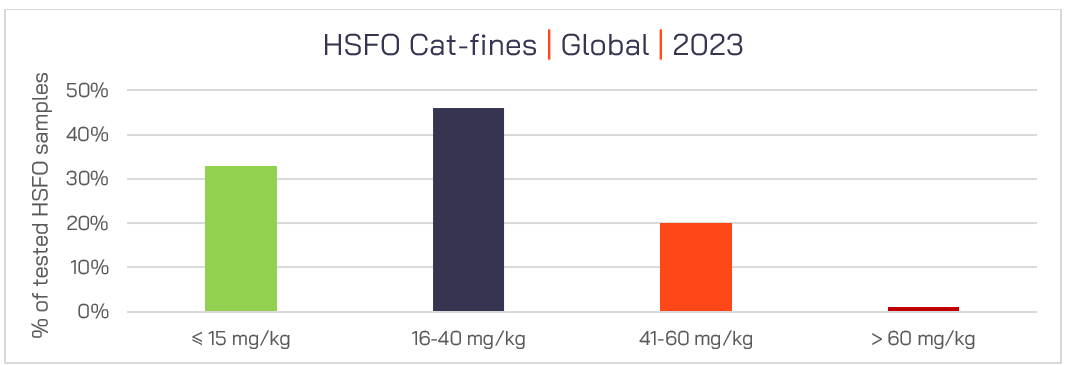
With both VLSFO and HSFO we did see cases of vessel damages due to chemical contamination during 2023. Focusing specifically on the VPS GCMS-Head Space Chemical Screening service, as a damage prevention service, 19.9% of applicable marine fuel samples received by VPS since 2018, have undertaken this rapid, pre-burn protection service, with an average 8% of samples tested, giving rise to a “Caution” result, indicating the presence of at least one chemical contaminant.
MGO Fuel Quality
MGO accounts for 14% of all samples received by VPS for testing. Many ship owners and operators choose not to test MGO, believing this fuel type is problem-free. However, this could not be further from the truth. In 2023, Singapore accounted for 15.9% of all MGO off-specifications, which was a huge increase on the 6.6% Singapore experienced in 2022. Asia-Pacific was the next highest region in terms of MGO off-specs with 8.4%, followed by Europe showing 8% of all MGO off-specifications.
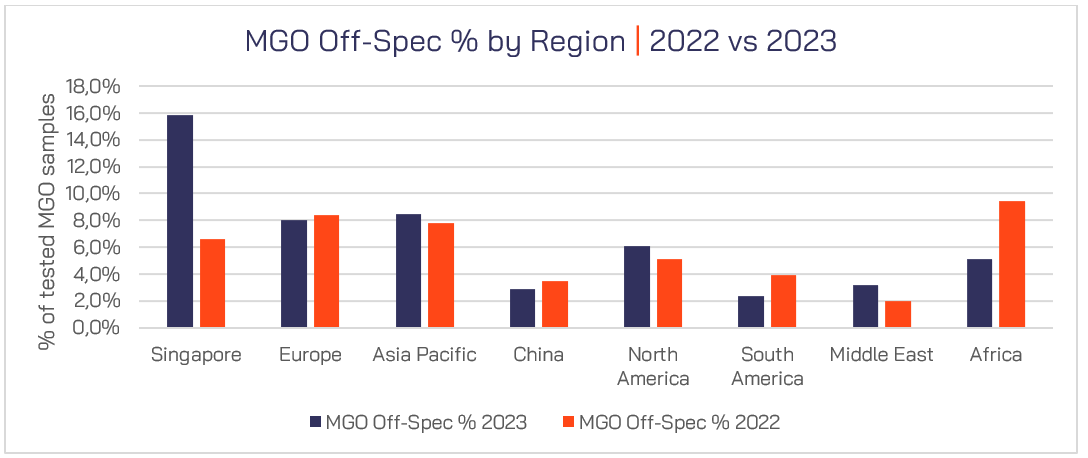
Pour Point was the most common MGO off-specification parameter in 2023, with 36.6% of MGO off-specs attributed to Pour Point. During the last quarter of 2023 we witnessed a significant increase in Pour Point (& CFPP), cold-flow property related issues in the ARA region & Gibraltar for distillate fuels and the potential wax-precipitation from these fuel which could occur.
FAME contamination was the second most common MGO off-specification parameter accounting for 32.1% of all MGO off-specs. As FAME is a common component within automotive, aviation fuels and now some marine fuels, it is not surprising we are seeing such levels of off-specification.
Flash Point was the third most common MGO off-specification parameter, with 12.6% of MGO off-specs attributed to Flash Point. Flash Point, accounted for 28% of the Bunker Alerts in 2023, with three out of eight Flash Point Bunker Alerts being for MGO fuels.
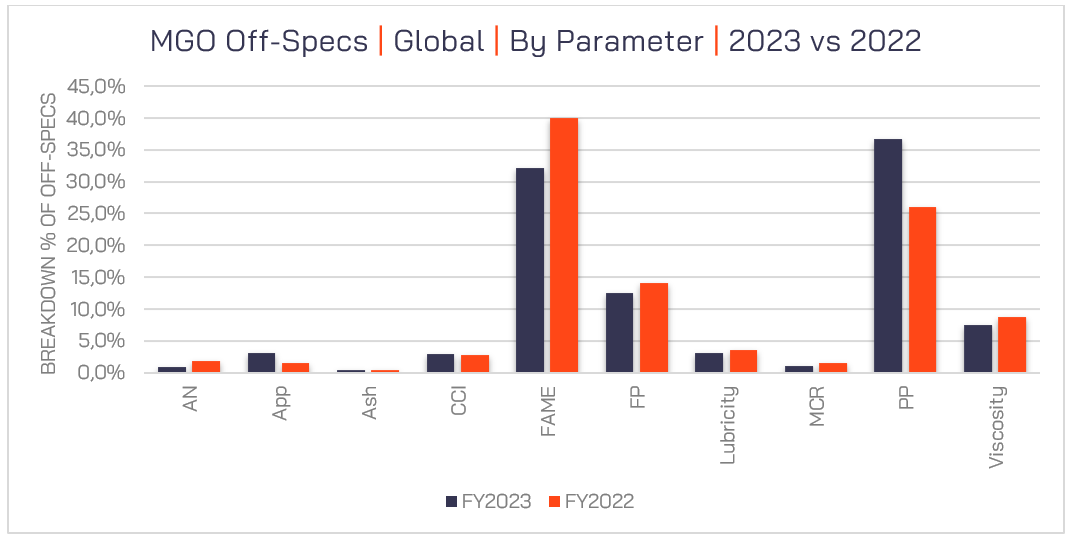
Biofuels
As global shipping looks towards low-to-zero carbon fuels to answer many emissions reduction challenges, biofuels offer an immediate “drop-in” solution. As such VPS tested the equivalent of over 500,000 MT of biofuels in 2023 compared to ca. 230,000 MT in 2022.
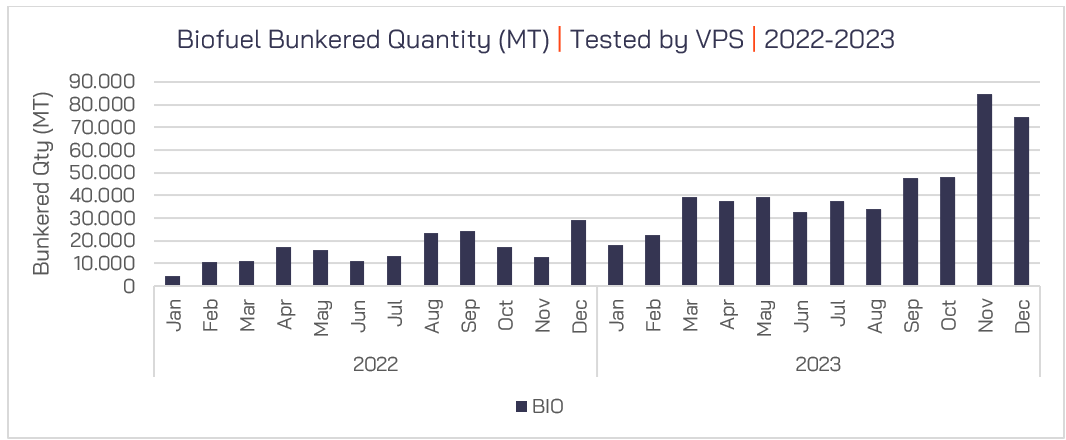
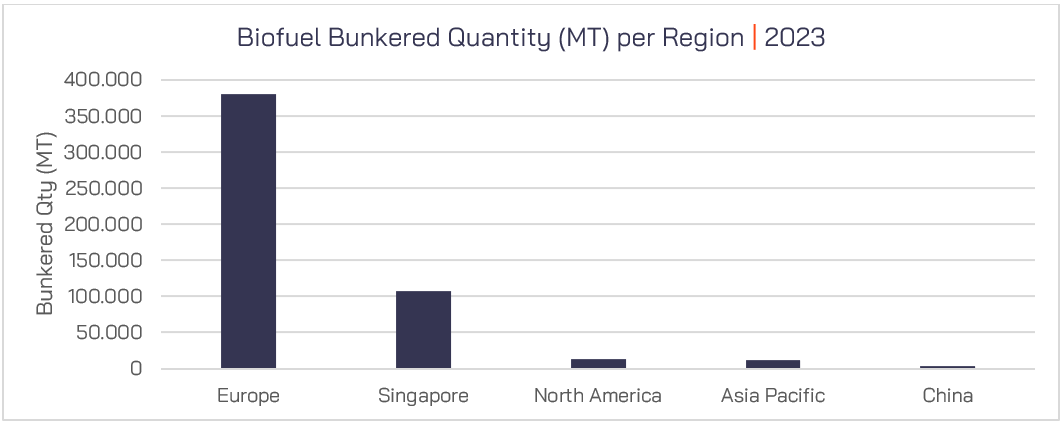
Europe, (mainly ARA-region) provided the highest volume of biofuels at almost 400K MT (ca. 74%) and Singapore second (ca. 21%), providing just over 100K MT.
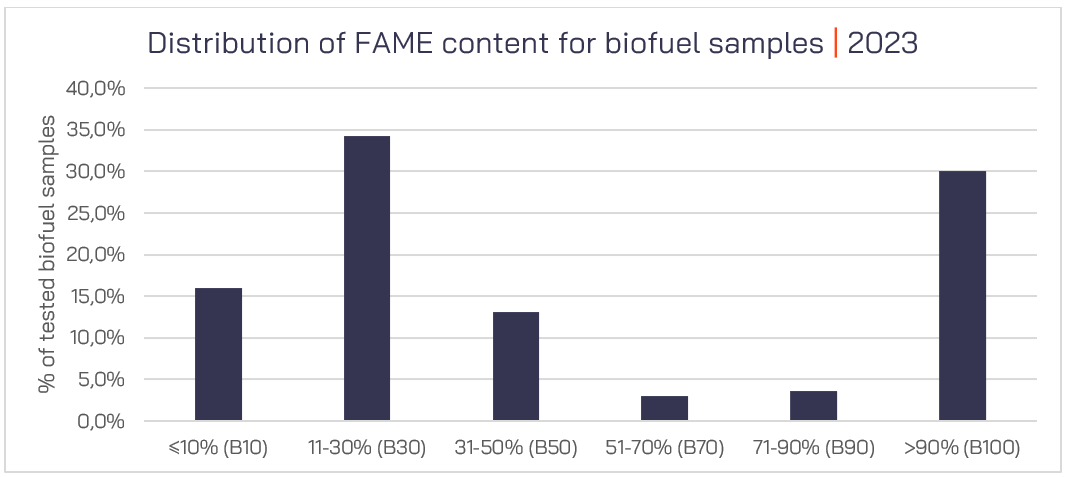
The most common biofuel blend was B30 (10-30% bio), which accounted for 34.3% of biofuel samples tested by VPS. Yet, B100 (>90% bio) was not far behind with 30.1%.
The majority of biofuels contained Fatty Acid Methyl Esters (FAME) as the bio-component, although VPS did test others containing HVO, HEFA, Cashew Nut Shell Liquid (CNSL) and Tyre Pyrolysis Oil (TPO).
Where FAME is the bio-component within marine biofuels, the key considerations are:
- Energy Content, Renewable Content
- Fuel Stability, Cold-Flow Properties
- Corrosivity, Microbial Growth
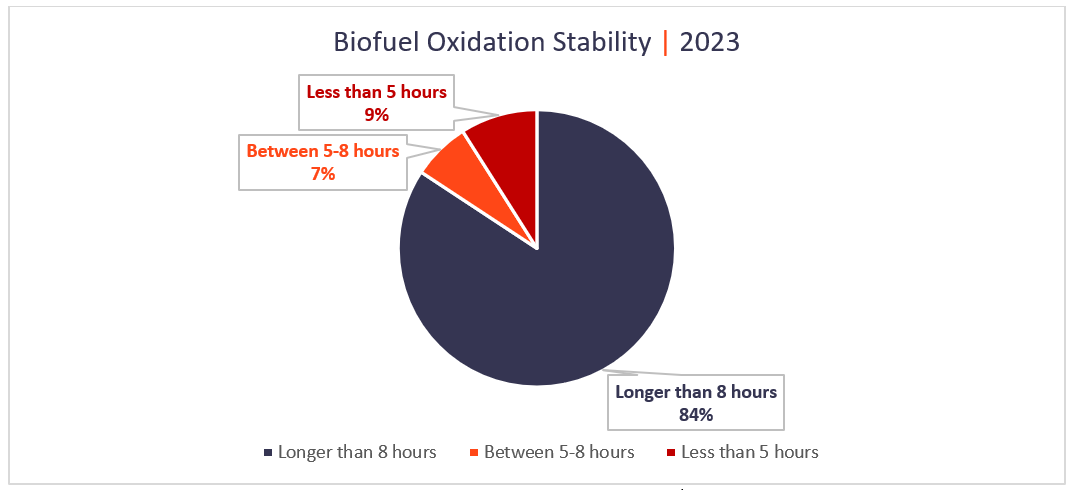
Of the biofuels tested by VPS in 2023, 9% of those tested for oxidation stability gave the concerning result of <5 hours, highlighting a high degree of instability, whilst 6.7% gave a result of 5-8 hours which is still a cause for concern.
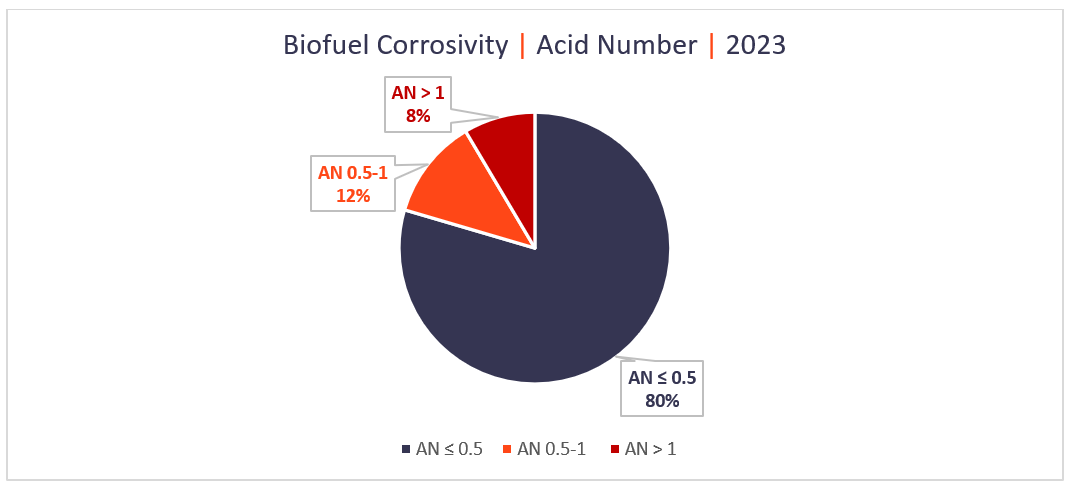
In terms of corrosivity, 11.9% of those biofuels tested provided an amber/caution result, whilst 8.5% of those tested provide a red warning, indicating potential high levels of corrosivity.
It is fully expected that the growth in biofuels usage for marine applications will continue to increase across 2024 and the VPS Additional Protection Service (APS) when using biofuels, will only increase in importance as the industry looks for more information regarding the fuel management of biofuels.
Summary
2023 once again highlighted the importance of bunker fuel quality testing, as a proactive means to protect vessels, their crew and the environment. With additional tests, currently not included within ISO8217, providing further vital information in achieving heightened levels of protection.
Whilst we can expect a new revision of ISO8217 in early 2024, additional tests will still hold an important role in fuel management.
Biofuels usage will continue to increase in demand and importance, as ship owners and operators look to achieve improvements through CII and EEXI, as well as looking to counter the financial impact of the EU ETS scheme.
Methanol demand and usage will also grow, following the recent success of Maersk’s Laura Maersk and the rapidly growing order book for methanol-powered vessels.
So 2024, suggests another year of widening marine fuel types and grades coming to market, coupled with their growing fuel management considerations.
For further support to your fuel management issues, please contact marketing@vpsveritas.com
VPS wins OSJ Annual Environment Award 2024 for the Maress Summer Campaign
We are proud to announce our victory in the prestigious OSJ Annual Environmental Award 2024, presented by Riviera Maritime Media Ltd and The Offshore Support Journal Community.
The award recognizes VPS's role in initiating and coordinating the Maress Summer Campaign.
The Maress Summer Campaign exemplifies collaborative excellence, engaging eight vessel owners and 133 vessels in a concerted effort that resulted in savings of an impressive 10,000 tons of CO2 emissions. This remarkable feat underscores the commitment of vessel crews and the collective action taken by participating companies.
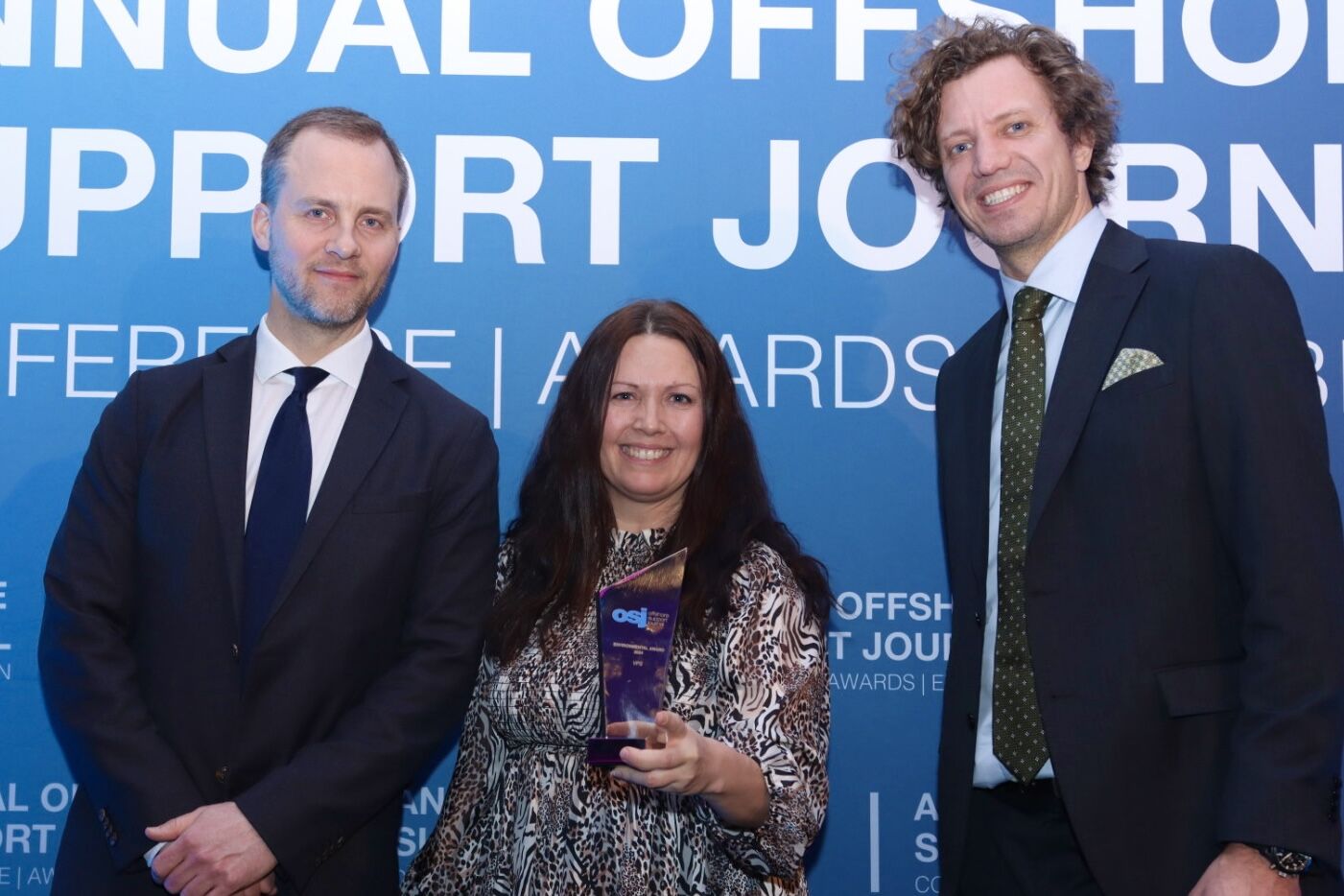
Malcolm Cooper, VPS CEO:
"The amount of savings achieved by the vessels in this campaign is just staggering and inspirational. My congratulations to everyone that participated. For us in VPS it is a key part of our strategy to help the industry decarbonise by leveraging the unique data access that we as a company have on maritime fuels and emissions. All the vessels in this campaign are using our data-driven decarb software Maress, and creating collective action and results for our customers - such as in this campaign - is something that we will aspire to do more of".
VPS extends its gratitude to all participating companies and crews, including Solstad Offshore ASA, Simon Møkster Shipping AS, Boskalis Offshore Energy, Rem Offshore, Tidewater, Skansi Offshore, North Sea Shipping, and DOF. Together, they have demonstrated the potential for collaboration and innovation in addressing environmental challenges within the maritime industry.
VPS is looking forward to the 2024 version of the Maress Summer Campaign - and we hope that the number of participating vessels and total savings this year will be even larger than in the 2023 campaign! For companies interested in learning more on how to engage, please reach out to us: decarbonisation@vpsveritas.com
VPS’ data-driven decarbonisation solution Maress combines available data from vessels with other relevant datasets to provide insights on how to reduce fuel and emissions.
vpsveritas.com
 Search
Search
 Customer
Customer